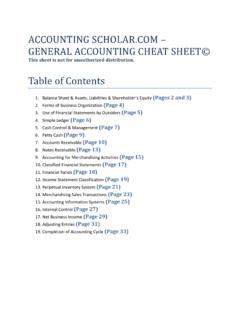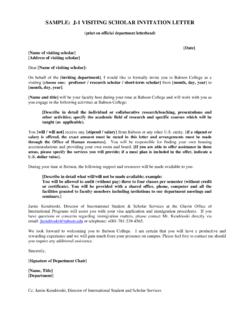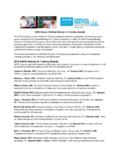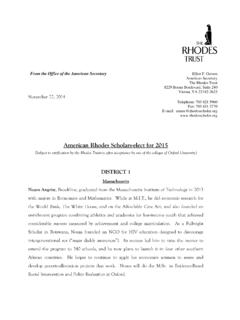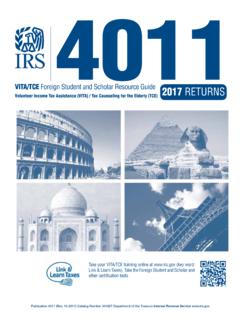Transcription of ACCOUNTING SCHOLAR.COM GENERAL …
1 ACCOUNTING GENERAL ACCOUNTING CHEAT SHEET This sheet is not for unauthorized distribution. Table of Contents 1. Balance Sheet & Assets, Liabilities & Shareholder s Equity (Pages 2 and 3) 2. Forms of Business Organization (Page 4) 3. Use of Financial Statements by Outsiders (Page 5) 4. Simple Ledger (Page 6) 5. Cash Control & Management (Page 7) 6. Petty Cash (Page 9) 7. Accounts Receivable (Page 10) 8. Notes Receivable (Page 13) 9. ACCOUNTING for Merchandising Activities (Page 15) 10. Classified Financial Statements (Page 17) 11. Financial Ratios (Page 18) 12. Income Statement Classification (Page 19) 13. Perpetual Inventory System (Page 21) 14.
2 Merchandising Sales Transactions (Page 23) 15. ACCOUNTING Information Systems (Page 25) 16. Internal Control (Page 27) 17. Net Business Income (Page 29) 18. Adjusting Entries (Page 31) 19. Completion of ACCOUNTING Cycle (Page 33) The Balance Sheet Used to show the financial position of a business entity on a specific date. They are always prepared at the end of the year and often more often. A balance sheet lists the businesses' assets, liabilities and owner's equity. The balance sheet is dated because the financial position can change quickly. Features: Heading Three Sections: assets, liabilities and owner's equity.
3 Business Entity - business finances must be kept separate from personal affairs of the owner. Assets Assets are economic resources that are owned by a business and are expected to benefit future operations. Examples: buildings, machinery, accounts receivable. Valued at cost that is what you paid for the asset, not what it is worth today. Generally Accepted ACCOUNTING Principles (GAAP) Cost Principle Valued at cost that is what you paid for the asset, not what it is worth today. Going-Concern Assumption (assets are acquired for use not resale) Objectivity Principle Objective - factual and can be verified by others.
4 Stable Dollar Assumption - even though inflation may have changed value of old dollars, they are thought of as new dollars. Liabilities Debts of a business All businesses have debts. It is convenient to buy with credit The purchase of goods of services for credit is an account payable When money is borrowed it is a note payable Owner's Equity Represents the resources invested by the owner Residual claim because claims of creditors come first Equal to the total assets minus the total liabilities Increase in Owner's Equity comes from 1) Investment and 2) Earnings Decreases come from 1) Withdrawals and 2) Losses The ACCOUNTING Equation Assets = Liabilities + Owner's Equity Always One side shows what a business owns and the other side shows who supplied these resources.
5 All assets have been supplied by creditors or the owner Forms of Business Organization Sole Proprietorship A business owned by one person. The most common form of ownership in our economy. stores, farms, service businesses. From an ACCOUNTING viewpoint, it is a business entity separate from the affairs of the owner. From a legal standpoint, they are not separate entities and the owner is personally liable for the debts of a business. If the business fails, creditors may force the owner to sell personal assets to pay off debts. Partnerships an unincorporated business owned by two or more persons. not legally an entity separate from its owners (owners are personally responsible for debts of the business).
6 ACCOUNTING practices sees the business as separate from personal affairs. Corporations the only type of business recognized legally as separate from its owners (owners are not personally responsible for debts). limited liability - you can only lose what you have invested in the business. owners are shareholders and hold transferable shares of capital stock (the stock can be sold). most large businesses are organized as corporations. R e p o r t i n g O w n e r s h i p E q u i t y i n t h e B a l a n c e S h e e t Sole Proprietorship - the equity section contains only the equity of the proprietor.
7 Partnership - Partner's Equity is used instead of Owner's Equity and the amount of each partner's equity is listed separately. C o r p o r a t i o n - u s e t h e t i t l e S h a r e h o l d e r s E q u i t y Shareholders equity is divided into capital stock (amount originally invested in the business) and retained earnings (the amount of increase in shareholder's equity that has resulted from profitable business transactions). The Use of Financial Statements by Outsiders financial statements are used outside of the business to make investment decisions. creditors and investors are concerned with the solvency and profitability of the business.
8 Solvency - the ability of a business to pay debts when they come due. If a business can meet its obligations it is called solvent. If a business cannot pay debts, it is insolvent and may face bankruptcy. A bankrupt business may have to stop operations, sell its assets to pay creditors and end its existence. Profitability - a business is profitable when revenue exceeds expenses for an ACCOUNTING period. This increases the value of the owner's equity. The Simple Ledger Account - A form in which changes caused by transactions are recorded. There is one account for each item affecting the financial position (each asset, liability, and owner's equity) Ledger - All of the accounts together also called a group of accounts the data from the balance sheet is used to set up the accounts.
9 The dollar figure for the account is written on the first line. This is the beginning value of the account. the dollar figure must be recorded on the side that the account appears in the balance sheet. Debit/Credit Debit refers to the left side of any account. Credit refers to the right side of any account. Any Account Debit Credit 1. The normal balance of any account goes on the same side that it appears on the balance sheet (Asset - Left) 2. Increase on the balance side. 3. Decrease on the side opposite the balance. Analyzing Transactions 1. What accounts? 2. Classification 3. Increase/ Decrease 4. Debit/Credit 5.
10 How much? Cash Control & Management cash is money on deposit or any items that a bank will accept for deposit. The cash account is a controlling account for perhaps many bank accounts. Cash on the balance sheet listed first because it is available to meet obligations. it is the most liquid asset, assets are listed in order of liquidity. some short term investments are so liquid that they are combined with cash on the balance sheet. creditors are interested in how cash compares with accounts payable. Is the company able to pay debts as they become due? This is called solvency. Statement of Changes in Financial Position this statement summarizes all of the cash activity during the ACCOUNTING period.
